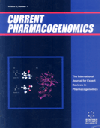- Home
- A-Z Publications
- Current Pharmacogenomics
- Previous Issues
- Volume 3, Issue 4, 2005
Current Pharmacogenomics - Volume 3, Issue 4, 2005
Volume 3, Issue 4, 2005
-
-
Selection of Microbial T-Cell Epitopes for Immune-Diagnosis, Immune- Therapy and Vaccine Design
More LessAuthors: Fouad Seghrouchni, Floriana Berretta and Massimo AmicosanteThe ability to induce and/or monitor an immune response to a broad repertoire of epitopes universally recognized across continents and genetic backgrounds is considered a critical characteristic of an effective vaccine and diagnostic tool. Opportunities for epitope identification are expanding as the number of entirely sequenced pathogens approaches 500 and access to this data improves. The pace of vaccine design will accel Read More
-
-
-
Pharmacological Suppression of Premature Stop Mutations that Cause Genetic Diseases
More LessAuthors: K. M. Keeling and D. M. BedwellAminoglycoside antibiotics have long been used as antibacterial agents due to their ability to inhibit bacterial translation. However, aminoglycosides also stimulate translation errors in mammalian cells. Aminoglycosides bind to a pocket formed in a domain of the ribosomal RNA (rRNA) of the small ribosomal subunit that constitutes the decoding site in both prokaryotes and eukaryotes. Normally, accurate base pairing takes pla Read More
-
-
-
Hypertensive Pharmacogenomics in African Americans
More LessHypertension affects 60 million Americans and is the most common disorder for which medications are prescribed in the USA. Hypertension associates with serious complications including stroke, heart failure, ischemic heart disease, and renal failure. Racial background associates with the prevalence and complications of hypertension with African Americans more frequently and severely affected. Hypertensive African Read More
-
-
-
Genomics and Proteomics of Nucleoside Transporters
More LessAuthors: German Reyes and Imogen R. CoeNucleoside transporters are a group of poorly understood membrane proteins involved in the movement of nucleoside and many nucleoside analogs across cell membranes. Nucleoside analog drugs are used routinely in various types of chemotherapy. These drugs have been widely used for many years with good results. However, variability in patient response and both de novo and acquired resistance continue to be maj Read More
-
-
-
DNA Microarray-Based Gene Expression Profiling in Cancer: Aiding Cancer Diagnosis, Assessing Prognosis and Predicting Response to Therapy
More LessA DNA microarray is a solid support such as a glass slide, silicon chip or nylon membrane on which DNA molecules are attached at precise locations. Using DNA microarrays, the expression of tens of thousands of genes in a biological sample can be detected in one experiment. Emerging data suggests that the use of DNA microarrays can aid the differentiation of tumors with similar morphological appearance, p Read More
-
-
-
A Candidate Pathway Strategy for Integration of Pharmacogenomic Components of Variability in Antipsychotic Treatment Outcomes: A Focus on Aripiprazole
More LessAripiprazole is the first atypical antipsychotic introduced to medical practice with partial dopamine-serotonin agonist properties. Other new molecular entities such as bifeprunox, a partial agonist at the dopamine D2 and serotonin 5- HT1A receptors, are currently being evaluated in early stage drug development as potential antipsychotic agents. As a partial agonist, whether aripiprazole displays an agonist effect or attenu Read More
-
-
-
Identifying Biomarkers of Lung Cancer in the Post-Genomic Era
More LessBy Jingwu XieIn the last two decades, we have witnessed an exponential growth of our knowledge on cell growth and neoplastic transformation at the molecular level. There is high expectation that these advances will be translated into further improvement in the care of cancer patients, especially in the areas of diagnosis, prognosis and treatment. With the completion of the human genome project and numerous studies on gene expressi Read More
-
Volumes & issues
Most Read This Month
Article
content/journals/cpg
Journal
10
5
false
en


